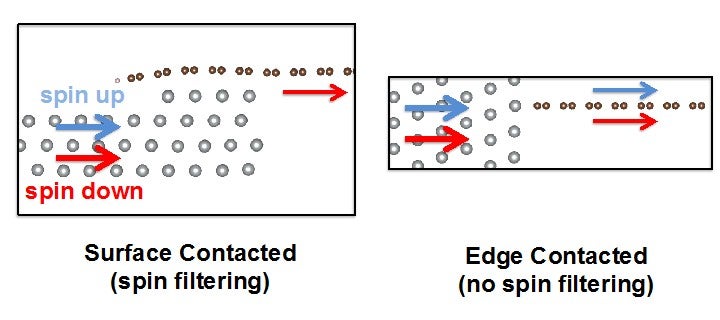A new spin on graphene electronics
QUEK Su Ying ((Group Leader, Physics)) May 18, 201718 May 2017. NUS physicists have discovered that controlling electron spin can lower contact resistance in graphene electronics for high performance devices.
Electronic devices with lower resistance between connections uses less power. These devices are also less likely to have localised heating effects. Graphene, a flexible material with exceptionally high electron mobility and thermal conductivity, is a material for next generation electronics. However, it has a large resistance when used in electrical connections. The construction of smaller and more efficient electronic devices is hindered partly by heat generated within the device. If this resistance can be lowered, electronic devices will be able to operate at a higher speed using less power. An NUS team has now shown how the contact resistance can be reduced in graphene devices by manipulating the spin state of the charge carriers.
Although graphene is a prime candidate material for next generation electronics the large electrical resistance at metal-graphene interfaces is a bottleneck for practical devices. A collaboration between Prof Su Ying QUEK from the Department of Physics, NUS and Prof John THONG from the Department of Electrical and Computer Engineering, NUS has shown that “edge-contacted” device geometries in Ni/Co-graphene interfaces result in some of the lowest contact resistances reported to date. The resistance in such geometries is significantly lower than in “surface-contacted” Ni/Co-graphene interfaces. This is due to the different behaviour of electron spins in these geometries. Temperature-dependent measurements show that electron spin indeed can control the contact resistance at ferromagnetic-graphene interfaces.
There have been significant efforts in graphene research due to its unique material properties including high electron mobility, excellent mechanical strength and flexibility, and high thermal conductivity. This has prompted the use of graphene as a potential material for on-chip interconnects and high-speed transistors for next generation electronic circuits. However, the large electrical resistance at the metal-graphene interface limits the performance of these devices.
In this work, the researchers examined the contact resistance of edge- versus conventional surface-contacted ferromagnetic metal-graphene interfaces. They found that the contact resistance of edge-contacted interfaces is much lower, with resistances comparable to the lowest values reported to date. They showed that the higher contact resistance arises from the spin filtering phenomena at the metal-graphene interface. This is in contrast to previously reported work, where it is widely believed that the higher resistance is a result of weaker coupling strength. By using edge contacts, one essentially allows charge carriers of both majority and minority spin to pass from the electrodes to graphene, resulting in almost twice the number of carriers and reducing the contact resistance significantly. These findings suggest that the contact resistance in graphene devices could be adjusted by tuning the spin state of the magnetic metal.
The research team plans to explore tuning the contact resistance in ferromagnetic metal-graphene contacts by varying the spin state of the metal. They also intend to investigate other device parameters such as spin injection efficiency and spin lifetime at these interfaces for spintronics applications.

Figure shows the schematic for edge- and surface-contacted ferromagnetic metal-graphene interfaces with spin-up and spin-down current flows denoted by blue and red arrows, respectively.
Reference
Khoo KH; Leong WS, Thong JTL* and Quek SY*, “Origin of contact resistance at ferromagnetic metal-graphene interfaces”, ACS NANO Volume: 10 Issue: 2 Pages: 11219-11227 DOI:10.1021/acsnano.6b06286 Published: 2016


